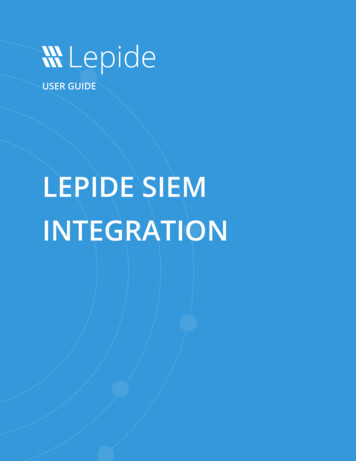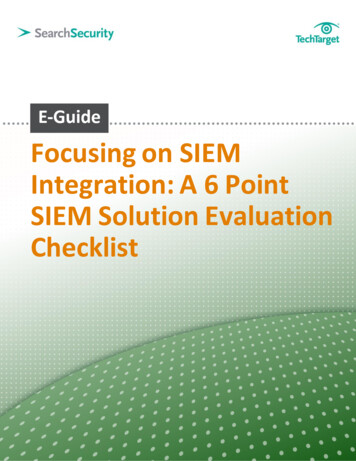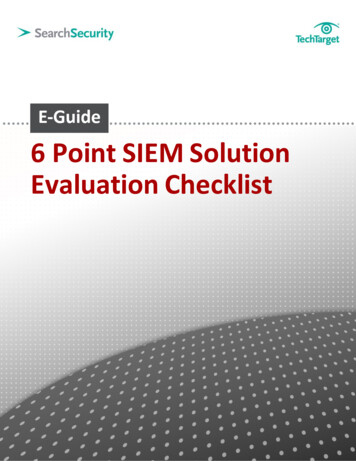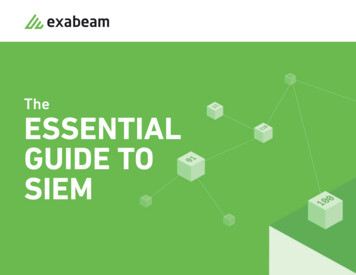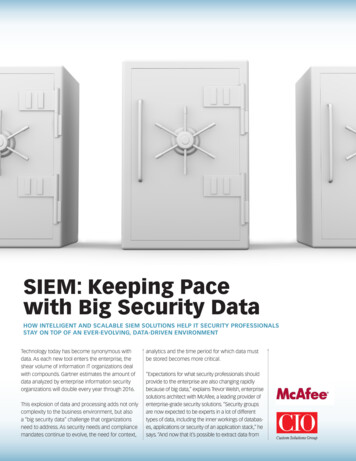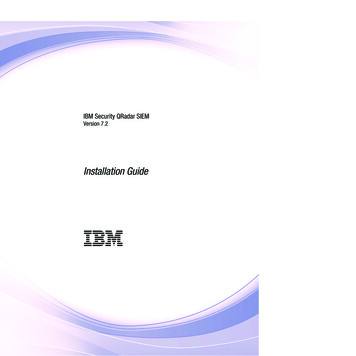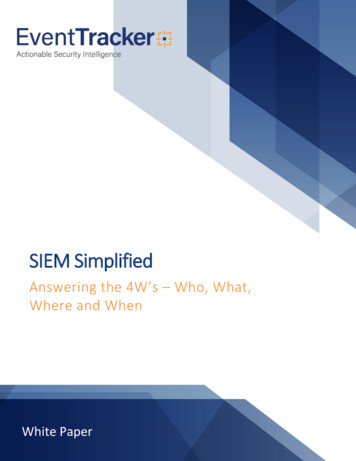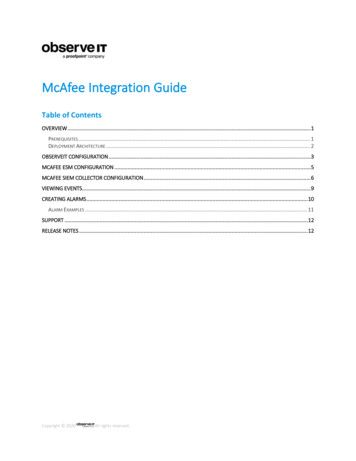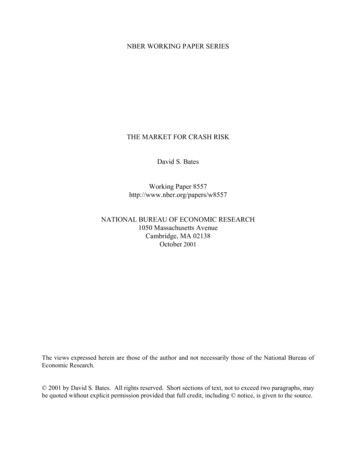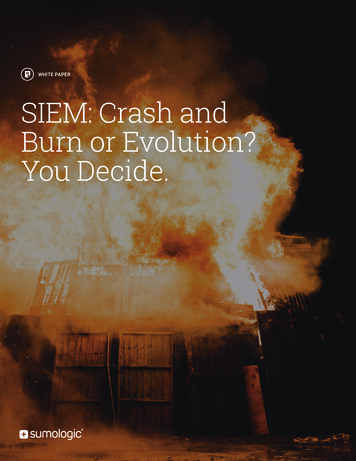
Transcription
WHITE PAPERSIEM: Crash andBurn or Evolution?You Decide.
WHITE PAPER SIEM: Crash and Burn or Evolution? You Decide.SIEM stands for Security information and event managementand these solutions have been around since 2000. They weredeveloped with the goal of helping organizations in the earlydetection of targeted attacks and data breaches.But SIEMs have struggled to keep pace with the security needsof modern enterprises, especially as the volume, variety andvelocity of data has grown. As well, SIEMs have struggledto keep pace with the sophistication of modern day threats.Malware 15 years ago was static and predictable. But today’sthreats are stealthy, and polymorphic.“Often times when presenting at conferences, people will ask“Is SIEM Dead”? Such a great question! Has the technologyreached its end of life? Has SIEM really crashed and burned?I think the answer to that question is NO. SIEM is not dead,it has just evolved.12000Threat Management2004Compliance ReportingThe Evolution of SIEM - Transitioning to Security Analytics. Source: Forrester Research, Inc.2011Security Analytics2015
WHITE PAPER SIEM: Crash and Burn or Evolution? You Decide.In speaking with hundreds of customers, and prospects, the reality is that few enterprises have theresources to dedicate to the upkeep of SIEM and the use of the technology to address threat managementhas become less effective and waned. Gartner Analyst Oliver Rochford famously wrote, “ImplementingSIEMs continues to be fraught with difficulties, with failed and stalled deployments common”.2In Greek mythology, a phoenix (Greek: φοῖνιξ phoinix; Latin: phoenix,systems, and applications in real time. This is dealing with thephœnix, fenix) is a long-lived bird that is cyclically regenerated ormonitoring, correlating, and notification of security events that arereborn. Associated with the sun, a phoenix obtains new life by arisinggenerated across the IT infrastructure and application stack.from the ashes of its predecessor.Although folks generally do not distinguish between these two areasThe SIEM ashes are omnipresent and Security Analytics are emerginganymore, and just use “SIEM” to describe the market category, oneas the primary system for detection and response.should really take note of what they are trying to accomplish andwhat problems they are trying to solve by bringing about these kidsDeconstructing SIEMAlthough we use the term SIEM to describe this market, SIEM isreally made up of two distinct areas:of solutions.Why Do We Care About SIEM?One could easily dismiss these solutions outright, but the security1. SIM or Security Information Management (SIM) deals with thestorage, analysis and reporting of log data. SIM ingests data frommarket is huge - 21.4B in 201 according to our friends at Gartner.And the SIEM piece alone reached 1.6B last year.host systems, applications, network and security devices.2. SEM on the other hand, or Security Event Management (SEM),processes event data from security devices, network devices,According to 451 Research the security market has around1,500-1,800 vendors broken down into 7-8 main categories across3
WHITE PAPER SIEM: Crash and Burn or Evolution? You Decide.“There are two types of companies,those who have been hacked andthose who have no clue.”Executive Chairman and former CEOCisco Systems
WHITE PAPER SIEM: Crash and Burn or Evolution? You Decide.The Security Sector is Dynamic and Vast. We are Ceaseless & Vigilant in Our Coverage.Source: Momentum Partners.IAM, EPP, SIEM, SMG, SWG, DLP, Encryption, Cloud Security, etc.When I graduated university back in the late 80’s, I was a computerAnd within each of these main categories, there are numerousprogrammer for a large insurance company, working on IBMsub categories.mainframe applications (IMS DB/DC and CICS DB2). These werelarge monolithic applications, self-contained, with long development,And despite the billions of dollars invested, current security andtesting and delivery cycles that took 12-18 months. We sat down withSIEM solutions are struggling to keep the bad guys out. Whetherusers, collected requirements, built prototypes, and went through unit,cyber criminals, corporate spies, or others, these bad actors areregression and QA testing before rolling things into production –getting through.OLD SCHOOL.The Executive Chairman and former CEO of Cisco Systems famouslyThink about modern digital companies that are successful todaysaid, “There are two types of companies, those who have been hacked– Airbnb, Netflix, Uber, Amazon, Skype, Twitter, LinkedIn to nameand those who have no clue.” Consider for a moment that the mediana few. These companies – in order to drive continuous innovation# days before a breach is detected is over 6 ½ months and that theand continue to be relevant to their customers - are leveraging micro% of victims notified by external 3rd parties is almost 70%.3 Peopleservices, containers like Docker, configuration management toolsindeed have no clue! Something different is clearly needed.like Chef and Puppet. They are driving continuous delivery initiativesweekly, even daily, at a pace we have not seen before. And to supportSIEM and Security Analytics: Head to HeadSIEMS were a great technology when we were dealing with protectingthis rapid pace, organizations are looking to leverage modern,advanced IT infrastructure for a majority of these workloads suchas from public cloud providers like AWS or Azure.the known, with fixed perimeters and signature-based security. Butis this reflective of today’s dynamic threat landscape, with a porousSo when you think about the CI/CD lifecycle, and the cloud-basedperimeter and workloads moving to the cloud?infrastructures these modern applications are running on, we are5
WHITE PAPER SIEM: Crash and Burn or Evolution? You Decide.dealing with a lot of layered components - OS, Applications, NWat surfacing up known events, but what about the unknown events?devices, Storage devices, servers and workstations, etc. - and all thisWhat happens when you do not even know the questions to ask? Withinfrastructure produces a lot of data, siloed data. When you consider themillions of event and log data being generated daily, finding thesevolume, variety and velocity of the data streams, it becomes extremelyindicators of compromise (IOCs) are like trying to find the needle in thechallenging – leveraging SIEMs - to ingest this capacity and extracthaystack. It becomes humanely impossible.answers and insights in a timely fashion. The SIEM architecture wasbecoming their Achilles heel and maybe, more appropriately, a ball andThis is where Security Analytics solutions steps in. By leveragingchain around their ankle.machine learning algorithms and data science, they are able toidentify abstract relationships, anomalies and trends and surface upAdditionally, as organizations move into this digital world, developingproblems automatically. Security analytics solutions look at themodern applications, leveraging mobile, social, information and clouddata more holistically, providing full-stack visibility across onto deliver new and disruptive experiences to their customers, thehybrid infrastructures.predictability of workload volumes is less certain. Think about whathappens to Airbnb during Thanksgiving travel season? Or Target duringTo summarize, below are the six takeaways on the SIEM vs. Securitythe Xmas shopping season? And how requests for Uber rides spike duringAnalytics debate that I’ve pulled together based on industry analysts’a major sporting like the super bowl? This capacity has to be planned for,and thought leaders’ feedback. Use them as a guide for your futurethe hardware and software need to be provisioned, the people allocated,security solution investments.and so on. This takes time, money and foresight. Wouldn’t a secure, highlyelastic, cloud-native, analytics service that bursts automatically as neededSix Takeaways on the SIEM vs. Security Analytics Debatebe a lot easier than over provisioning servers to handle spike volumes, butthat sit well below capacity for the majority of the year?1. Security data is unmanageable with legacy SIEM tools2. Advanced analytics are being integrated into security markets afterTo truly be rid of this ball and chain, one needs to move beyond therule and signature based prevention systems and tuning processesrigid, fixed correlation rules that generate so much alert fatigue amongstruggled to detect or stop most serious breaches over the pastInfoSec teams, that they are generally ignored. These rules were greatfew years.SIEMSecurity AnalyticsApplicationMonolithic Applications, Static, Longdevelopment and release cycles, Mode 1Modern Applications, Dynamic, Microservices,DevOps, Mode 2InfrastructureOn PremCloudExecution EnvironmentPlan for capacity growth (HW, SW, FTE)Elastic, Multi-tenant, SecureTime to Deploy15 months (avg.)Up and running in hoursCost 1.4M (HW, SW, People) 1,000 for 1GB daily ingestProtection CapabilitiesProtect the Known –Perimeter-based security using a definedsignature approachProtect the Unknown – Distributed cloud/hybrid cloud model using behavioral-based &continuous monitoring methodologies (acrossusers, applications, NW, data)Protection ApproachFixed-Rule Set(connect the dots)Machine Learning to identify abstract datarelationships, anomalies, trends, and fraudulentbehavioral patternsVisibilityIslands of Security / Limited view /Chokepoints / Port MirroringHolistic, Integrated, Risk-Based, Enterprise WideView / APIs & Native ServicesSIEM vs. Security Analytics comparison.6
WHITE PAPER SIEM: Crash and Burn or Evolution? You Decide.3. Security and risk professionals must evolve their tool set andcapabilities to keep up with the maturing threat landscape4. Consider threats that are already inside the enterprise: SIEM toolsAbout Sumo LogicSumo Logic is a secure, cloud-native, machine data analytics service,delivering real-time, continuous intelligence from structured, semi-are typically deployed to look at the perimeter of the network, yetstructured and unstructured data across the entire applicationthis mentality can expose organizations to great risklifecycle and stack. More than 1,000 customers around the globe rely5. Machine-learning algorithms and analysis techniques haveon Sumo Logic for the analytics and insights to build, run and secureadvanced far beyond the capabilities of what was available in thetheir modern applications and cloud infrastructures. With Sumo Logic,commercial markets only two to three years ago. They also addresscustomers gain a multi-tenant, service-model advantage to acceleratethe issue dubbed “We don’t know what we don’t know;their shift to continuous innovation, increasing competitive advantage,6. Security analytics’ core function is to monitor and collect vastbusiness value and growth.amounts of information from the environment to identify threatsthat indicate elevated risk and ultimately prevent lateral spread ofthose threats and data exfiltration. To succeed in this endeavor,the analytics platform performs the identification of threatsand prioritization of threats without the requirement for theSources:1Forrester: Evolution of SIEM graph, taken from Security Analytics is the Cornerstone ofModern Detection and Response, December 20152administrators and analysts to create policies or rules.Gartner: Overcoming Common Causes for SIEM Deployment Failures by Oliver Rochford21 Aug 20143Mandiant mTrends ReportsThis is truly a transformative shift that we see once a decade. Are youready to join the ride or are you content with the status quo?Additional ResourcesFind out how Sumo Logic helps deliver advanced security analyticswithout the pain of SIEMSign up for a free trial of Sumo Logic. It’s quick and easy. Within just afew clicks you can configure streaming data, and start gaining securityinsights into your data in seconds.Mark Bloom runs Product Marketing for Compliance & Security at SumoLogic. You can reach him on LinkedIn or on Twitter @bloom mark.Toll-Free: 1.855.LOG.SUMO Int’l: 1.650.810.8700 Copyright 2016 Sumo Logic, Inc. All rights reserved. Sumo Logic, Elastic Log Processing,305 Main Street, Redwood City, CA 9460LogReduce, Push Analytics and Big Data for Real-Time IT are trademarks of Sumo Logic, Inc.www.sumologic.comAll other company and product names mentioned herein may be trademarks of their respectiveowners. WP-0516. Updated 05/167
The SIEM ashes are omnipresent and Security Analytics are emerging as the primary system for detection and response. Deconstructing SIEM Although we use the term SIEM to describe this market, SIEM is really made up of two distinct areas: 1. SIM or Security Information Management (SIM) deals with the storage, analysis and reporting of log data.
